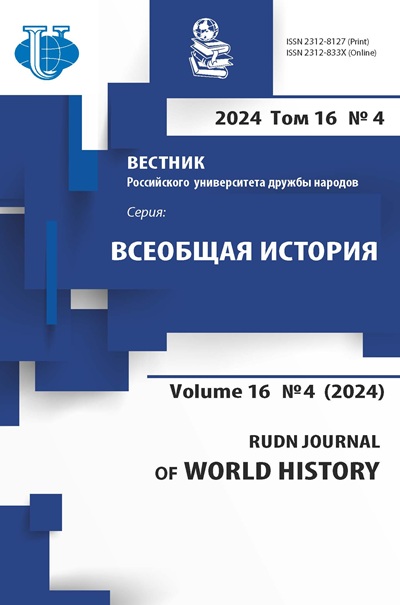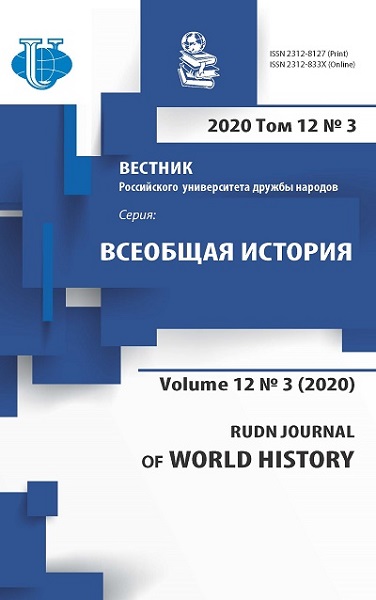The Features of Political and Religious Development of Oirats in the middle of the XIV - the middle of the XV centuries
- Authors: Kitinov B.U.1
-
Affiliations:
- Institute of Oriental Studies Russian Academy of Sciences
- Issue: Vol 12, No 3 (2020)
- Pages: 236-249
- Section: Oriental Studies
- URL: https://journals.rudn.ru/world-history/article/view/24730
- DOI: https://doi.org/10.22363/2312-8127-2020-12-3-236-249
Cite item
Full Text
Abstract
The period starting from the second half of the XIV century. and up to the middle of the 15th century, had held under the sign of the fall of the Mongol Yuan Dynasty in China, and it was the most important one in the history of the Eastern Mongols and Oirats. Until then, the rule that only representatives of the Golden Family (that is, the descendants of Genghis Khan) were able to receive power to govern over Mongols, was, in fact, not questioned, but later the various interpretations began to appear. For example, Oirats, as non-Genghisids, had to assert their power, possessing only second roles (Taishi - the first minister). Despite the internal turmoil and the struggle with the descendants of the Yuan rulers, the Oirats did to try to create the united Mongol state headed by Taishis from the Choros Oirat clan. After a long struggle with the Eastern Mongols (who sometimes had also been led by Oirats, for example Ugechi Khashig and his son Esehu) of such Oirat leaders as Batula, Batubolo, Taiping and Toghon, the son of the latter, Esen, managed to not only to unite the Oirats in a short time, but also to create the united Mongolian state. In addition, he revived the religious and political role of the sangha, most likely the teachings of black-caped hat Karma Kagyu. This act was especially important because, besides the ideological counterweight to the right of Genghisids, one should have responded to the growth of Islamic activity in the region.
About the authors
Baatr Uchaevich Kitinov
Institute of Oriental Studies Russian Academy of Sciences
Author for correspondence.
Email: histj@rudn.university
PhD, Associates Professor, Senior research fellow, Department of history of East
12, Rozhdestvenka str., Moscow, Russian Federation, 107031References
- Bichurin N.Ya. Historical review of Oirats or Kalmyks from the 15th century to the present. 2nd ed. Elista: Kalmyk Book Publishing House, 1991.127 p.
- Miyawaki J. The birth of the Oyirad khanship. Central Asiatic Journal. 1997. № 41/1. Рp. 38–75.
- Lubsan Danzan. Altan Tobchi (The Golden Legend). Transl. from Mong., Intr., comments and applications by N.P. Shastina. Moscow: Nauka Publishing House, 1973. 439 p.
- Elverskog J. The Pearl Rosary. Mongol Historiography in Early Nineteenth Century Ordos. The Mongolia Society, Inc., 2007. 196 р.
- Yellow Story (Shara Tuuji). Transl. from Mong., translit., intr. and comments by A.D. Tsendina. Moscow: Oriental literature, 2017. 406 p.
- Chernyshev A.I. The Public and State Development of Oirats in the 18th Century Moscow: Nauka Publishing House, 1990. 136 p.
- Zlatkin I.Ya. History of the Dzungar Khanate. 1635–1758. 2nd ed. Moscow: Nauka Publishing House, 1983. 331 p.
- Jamsran L. Attempts to Overcome a Crisis of State: the Oirats Gain in Strength. The History of Mongolia. Vol. II. Part 3. Yuan and Late Medieval Period. ed. by D. Sneath and C. Kaplonski. Global Oriental, 2010.
- Uspensky V. The Country of Kuke-Nor, or Qinghai, with the addition of a brief history of the Oirats and Mongols, after expelling of the latter from China, in connection with the history of Kuke-Nor. Notes of the Imperial Russian Geographical Society. 1880. Vol. 6. Pp. 59–196.
- Tsengel H. The Formation of the Dorben Oyirad Alliance. Ойрад ба дээд монголын туух, сурвалж бичгийн судлал. Улаанбаатар: Соембо принтинг, 2017. Pp. 73–89. (The Study of the Sources and History of Oirats and Upper Mongols).
- Zotov O.V. China and East Turkestan in the 15th – 18th centuries Interstate relations. Moscow: Nauka Publishing House, 1991. 168 p.
- Jagchid S. Trade, peace and war between the nomadic Altaics and the agricultural Chinese. Bulletin of the Institute of China Boarder Aare Studies. 1970. № 7.
- Saγang Sečen. Erdeni-yin Tobči (‘Precious Summary’). A Mongolian Chronicle of 1662. Canberra: Australian National University, 1990.
- Sneath D. The Headless State: Aristocratic Orders, Kinship Society, and the Misrepresentation of Nomadic Inner Asia. Columbia University Press, 2007. 273 p.
- Vladimirtsov B.Ya. The social system of the Mongols. The Mongolian nomadic feudalism. Vladimirtsov B.Ya. Works on the history and ethnography of the Mongolian peoples. Moscow: Eastern Literature, 2002. Pp. 295–488.
- Ramstedt G.I. Oirat name etymology. Collection in honor of the seventieth birthday of G.N. Potanin. Notes of the IRGO on the Department of Ethnography. Vol. XXXIV. St. Petersburg: V.U. Kirshbaum Printing house (Department), 1909. Pp. 547–558.
- Birtalan Á. An Oirat Ethnogenetic Myth in Written and Oral Traditions (A Case of Oirat Legitimacy). Acta Orientalia Academiae Scientiarum Hungaricae. 2002. Vol. 55. Iss. 1–3. Рp. 69–88.
- Haydar Mirza Muhammad. Tarih-i Rashidi. Introduction, transl. from the Persian by A. Urunbaeva, R.P. Jalilova, L.M. Epifanova. Tashkent: FAN Publishing House, 1996. 727 p.
- Richardson H.E. The Karma-Pa Sect. A Historical Note. Journal of the Royal Asiatic Society. 1958. October. Рp. 139–164.
- Karma Trinle. History of Karmapas of Tibet. Moscow: Diamond Way, 2010. 221 p.
- Karmay H. Early Sino-Tibetan Art. Aria & Phillips ltd., 1975. 128 р.
- Elverskog J. Buddhism and Islam on the Silk Road. University of Pennsylvania press, 2010. 340 p.
- Luo Zh. The status of China’s sovereignty in Tibet during the Ming dynasty. China Tibetology. 2015. № 1. Pp. 1–53.
- Levathes L. When China Ruled the seas: the Treasure Fleet of the Dragon Throne 1405–33. New-York: Simon and Schuster, 1994. 256 p.
- Jagchid S. Buddhism in Mongolia After the Collapse of the Yuan Dynasty. Bulletin of the Institute of China Boarder Aare Studies. 1971. № 2. Pp. 43–60.
- Serruys H. Sino-Mongol Trade During the Ming. Journal of Asian History. 1975. Vol. 9. № 1. Pp. 34–56.
- Schram L.M.J. The Monguors of the Kansu-Tibetan Border. Pt. 2. Their Religious Life. Philadelphia, 1957.
- Elverskog J. Sagang Sechen on the Tumu Incident. How Mongolia Matters: War, Law, and Society. ed. by Morris Rossabi. Brill, 2017. Pp. 6–17.
- Dictionary of Ming Biography. 1368–1644. Vol. 2. New-York – London, 1968. Pp. 1023–1751.
- Serruys H. The Office of Tayisi in Mongolia in the fifteenth Century. Harvard Journal of Asiatic Studies. 1977. Vol. 37. № 2. December. Рp. 353–380.
- Manz B.F. Family and Ruler in Timurid Historiography. Studies on Central Asian History in Honor of Yuri Bregel. Indiana University Uralic and Altaic Series. ed. by Devin DeWeese. Vol. 167. Bloomington: Indiana University press, 2001. Pp. 57–78.
- Elverskog J. Our Great Qing. The Mongols, Buddhism and the State in Late Imperial China. University of Hawai’i Press, 2008. 242 р.
- Gorokhova G.S. Mongolian sources about Dayan Khan. Moscow: Nauka Publishing House, 1986. 117 p.
- Bichurin N. Ya. Notes on Mongolia. Vol. 2. St. Petersburg: in the printing house of Karl Kraj, 1828. 333 p.
- Martynov A.S. The Status of Tibet in the 17th – 18th Centuries in the Traditional Chinese System of Political Thoughts. Moscow: Nauka Publishing House, 1978. 284 p.
- Sneath D. Introduction. The History of Mongolia. Vol. II. Part 3: Yuan and Late Medieval Period. Global Oriental LTD., 2010. Pp. 391–400.
- Baatr Kitinov. “The Oirats-Ogeleds… crossed the Mankan river”: the ethno-religious situation at the Oirats in the middle of XV – the beginning of XVI centuries. RUDN Journal of World History. 2017. Vol. 12. № 3. Pp. 370–382.












